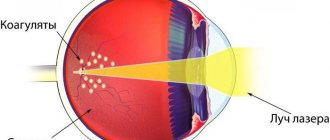The advent of the age of information technology subjects the human visual system to additional stress from childhood. Therefore, there are more and more people with refractive errors from year to year, and issues of vision correction are becoming increasingly important.
Today, laser correction, in the case of primary refractive errors, is a proven technology, thanks to which a predictable, stable result is obtained. It allows the patient to completely eliminate the use of glasses and contact lenses. True, modern patients no longer want to limit themselves to only high visual acuity; the requirements have increased significantly. Now most people need to have high-quality “super vision,” the achievement of which requires an individual approach to the patient’s refractive problem, taking into account his lifestyle and the characteristics of his professional activity.
It should be taken into account that some refractive errors (astigmatism over 2 diopters, high degrees of farsightedness and myopia) are difficult types of anomalies to correct and require a special approach.
Patients with such difficult optics often have a best-corrected visual acuity of less than 1.0, which is due to the presence of amblyopia, difficulty in contact correction, including complete intolerance to lenses. Performing laser operations on such patients using standard technologies is associated with the risk of serious problems (incomplete correction, overcorrection, instability of the refractive effect) after surgery, which leads to re-intervention.
The Moscow MNTK “Eye Microsurgery” successfully copes with the above problems, thanks to the availability of the most modern equipment for diagnostics and laser surgery, as well as highly qualified specialists working on staff.
Laser correction is performed here:
- Myopia, farsightedness, astigmatism.
- Induced refractive errors (after previous injuries, operations, eye diseases).
The following methods and technologies are available to patients:
- ReLEx SMILE
- FemtoLASIK
- Personalized corrections (taking into account data from keratotopograms and aberrograms)
- LASIK
- PRK
Over 30 years of work, over 320 thousand successful laser operations have already been performed. The institute’s specialists are proficient in all innovative technologies that allow predictive correction of any refractive error.
Story
At the end of the 19th century. The first attempts were made to use a microscope for operations. Operations using a microscope were initially performed only by ophthalmologists and otolaryngologists. Subsequently, the operating microscope and microsurgical methods began to be used in neurosurgery. Nylen (S. Nylen) in 1921 was the first to use a special operating microscope for ear surgery. Since that time, thin microsurgical instruments and suture material began to be created. Since the 70s operations using magnifying optics are beginning to be used in vascular surgery, plastic surgery, organ and tissue transplantation, gynecology, urology and other areas. In vascular surgery, microsurgical operations were first performed by Jacobson (J. Jacobson, 1960); The same author also authored work on experimental microsurgery of small-diameter vessels. In neurosurgery, the introduction of a new method is associated with the name of Rand (RW Rand, 1967), who performed thrombectomy on the middle cerebral artery. The founders of intracerebral microsurgery were Longheed and Pool (JV. Longheed, JL Pool, 1966), who were the first to use microsurgical methods for intracranial aneurysms.
Experimental microsurgery dates back to 1960. It is practiced in every microsurgical center, and the work is carried out in two directions: education and training of the surgeon; research into new possibilities of the method: development and improvement of new instruments, suture material, testing of new techniques (use of laser and ultrasound), creation in the laboratory. small animals of new experimental models (kidney transplantation, studying artificial blood circulation in rats, etc.).
International congresses and symposiums on microsurgery have been held since 1966. In a number of countries there are microsurgery centers with several specialized departments (hand injuries, plastic surgery, neurosurgery, gynecology, urology), a rehabilitation and physical therapy department, and an experimental laboratory. The main purpose of such centers is to provide emergency surgical care to victims of hand and finger injuries, because Replantation of fingers, hands, and limbs can only be done using microsurgical methods.
In the USSR, the first wedge, department of M. was organized in 1973 at the All-Union Scientific Research Institute of Clinical and Experimental Surgery M3 of the USSR (since 1980 - All-Union Scientific Center of Surgery of the USSR Academy of Medical Sciences) in Moscow. Later, M. centers appeared in a number of large cities and capitals of the Union republics; Their goal is, first of all, to provide emergency surgical care to patients with trauma to the hand and fingers, replantation of the fingers and hand, and operations on lymphatic and vascular tissues.
MNTK "Eye Microsurgery": history and tasks of the center
One of the priority research goals of the group was the creation of an intraocular lens (artificial lens). The progressiveness of the technique lay in the fact that until that moment, domestic ophthalmological science only meant that a foreign body could be removed from the eye, but not placed in it.
In 1974, the problem laboratory received the status of an independent scientific institution and became known as the Moscow Research Laboratory of Experimental and Clinical Eye Surgery (MRLEKKhG).
On September 11, 1980, by order of the USSR government, MNIILEKKHG was transformed into the Moscow Research Institute of Eye Microsurgery.
By order of the Council of Ministers of the USSR dated April 24, 1986, the Interdisciplinary Scientific and Technical Complex “Eye Microsurgery” was created on the basis of the research institute.
Currently, MNTK has 11 branches in large cities of Russia: Irkutsk, Khabarovsk, Yekaterinburg, Kaluga, Krasnodar, Novosibirsk, Orenburg, Volgograd, St. Petersburg, Cheboksary and Tambov; and five centers abroad.
The MNTK also includes experimental technical production and biochemical laboratories. 26 types of artificial eye lenses, instruments, diagnostic and operating equipment, and various drugs are manufactured here.
At MNTK, more than 85% of patients are treated using the latest scientific advances. Of the total volume of ophthalmological care in Russia, 30% falls on the share of the MNTK “Eye Microsurgery”. More than 60% of all high-tech operations in the country are performed here. In the total volume of surgical care at MNTK, 85% are operations of the highest and first categories of complexity.
Specialists of the Eye Microsurgery International Scientific and Research Center work in all high-tech areas of ophthalmology. These are vitreoretinal surgery, keratoplasty and keratoprosthetics (the Eye Bank of the Complex is the only one in Russia that has received an international certificate and is included in the Association of European Eye Banks), laser and ultrasound cataract surgery, laser surgery for glaucoma, refractive surgery for complex refractive errors, rehabilitation of patients with optic atrophy , organ-preserving direction in ophthalmo-oncology.
The team has developed and implemented a huge number of treatment methods and operations that have not been used anywhere in the world.
More than 5,000 specialists work in Moscow and 11 branches of the Complex. More than 1,200 eye surgeries are performed daily, and more than 300 thousand operations a year.
MNTK "Eye Microsurgery" is the largest base for the formation of the scientific potential of domestic ophthalmology.
Over two and a half decades, about five thousand Russian ophthalmologists and specialists from the former Soviet Union have mastered new treatment technologies at the Eye Microsurgery MNTK. Doctors from 30 countries of the world, including the USA, Germany, France, Greece, Italy, and Japan, were trained at the Complex.
VetLab training microsurgical operating rooms have been created in the Moscow, St. Petersburg, Yekaterinburg and Irkutsk branches, where young specialists are trained, advanced training courses for surgeons and training in new technologies are conducted. The VetLab system is the only one in Russia.
The publishing center MNTK publishes the journals “Ophthalmosurgery” and “New in Ophthalmology”, dedicated to the latest achievements in eye microsurgery in Russia and abroad
Founder and General Director (until June 2000) of the Eye Microsurgery MNTK named after. S.N. Fedorova - Academician of the Russian Academy of Medical Sciences, Professor Svyatoslav Nikolaevich Fedorov, author of more than 400 scientific papers and 164 inventions.
On June 2, 2000, academician Svyatoslav Fedorov died in a plane crash.
On July 10, 2000, the government of the Russian Federation decided to name the Intersectoral Scientific and Technical Complex “Eye Microsurgery” of the Ministry of Health of the Russian Federation after Academician S.N. Fedorov.
Since January 2001, the MNTK “Eye Microsurgery” has been headed by Doctor of Medical Sciences, Professor Hristo Periklovich Takhchidi.
On November 15, 2011, it became known that the Ministry of Health and Social Development of the Russian Federation dismissed the General Director of the Federal State Institution MNTK Eye Microsurgery, Hristo Takhchidi.
According to the press service of the Ministry of Health and Social Development, the reasons for the dismissal of the general director were complaints from patients, violations during public procurement and illegal commercial activities.
The material was prepared based on information from RIA Novosti and open sources
Eye microsurgery
Eye microsurgery (from the Greek micros - small) is a separate branch of ophthalmology that deals with the surgical treatment of intraocular structures that are inaccessible to the surgeon’s naked eye. Modern eye microsurgery is performed using high-resolution ophthalmic microscopes, special microsurgical instruments and atraumatic suture material, high-tech ophthalmic surgical and laser systems. In the middle of the last century, demands for eye surgeries increased sharply, which should be minimally traumatic, with expected and guaranteed results. The postoperative rehabilitation period should be short, painless, with a minimum number of postoperative restrictions. And over the past 30-40 years, eye microsurgery has made a qualitative leap, undergone a number of improvements, becoming more accessible and effective. Eye microsurgery has contributed to the modernization and improvement of many eye surgeries. Currently, eye microsurgery is widely used in the treatment of complex diseases such as glaucoma, cataracts, and retinal diseases, often being a routine practice for the operating ophthalmic surgeon.
In our clinic, eye microsurgery using an operating microscope, ophthalmological surgical combines, microinstruments and atraumatic suture material is performed daily both urgently and routinely for a wide range of surgical pathologies of the organ of vision and its auxiliary apparatus (more detailed information on the surgical treatment of eye diseases You can look here).
Today, eye microsurgery is of leading importance in cataract surgery. Modern technology for removing the cloudy lens using the “small incisions” technique allows to shorten the treatment time, reduce induced astigmatism, provides early clinical and functional rehabilitation of patients and high visual functions immediately in the first days after surgery.
Removing the lens through a micro-incision is impossible without fragmenting it (crushing) using mechanical or energetic influences. Ultrasound energy is most often used as an energy influence. For cataract surgery, the most modern “small incision” technologies are used: ultrasound phacoemulsification, Neosonix, AquaLase, mechanical phacofragmentation through a tunnel incision.
| A modern eye operating room must be equipped with an ophthalmic surgical unit for cataract surgery. The “Legacy Series 20000” Advantec series manufactured by Alcon (USA) is rightfully recognized as one of the best ophthalmic surgical systems. Currently, leading ophthalmology clinics are equipped with the company's latest development - the Infiniti tm phacoemulsifier, which will be a platform for subsequent modernization for the next 10 years. The reliability of any ophthalmic surgical unit is ensured by a built-in computer that controls the level of ultrasound, vacuum indicators, irrigation-aspiration, and the stability of the anterior chamber of the eye. This reduces the ultrasonic effect on eye tissue and increases the efficiency of the operation. The Infiniti tm surgical system is also unique in that it combines three methods of influencing the lens: improved progressive ultrasound, Neosonix technology - a combination of ultrasound and mechanical oscillations, AquaLase technology, which in some cases allows you to abandon ultrasonic vibrations, using crushing the nucleus of the lens with the energy of an ultra-fine jet of heated liquid. |
1. Surgical treatment of senile (age-related) cataracts.
In 95% of cases, age-related cataracts in our clinic are operated on using small incision technology using phacoemulsification using modern surgical systems manufactured by Alcon, USA. During the operation, only disposable imported consumables are used and soft intraocular lenses (IOLs) made in Europe and America are implanted, which eliminates the need for stitches at the end of the operation. 2. Eye microsurgery in the treatment of complicated cataracts with concomitant diseases: glaucoma, uveitis and iridocyclitis in remission, iridociliary dystrophy, complicated myopia, diabetic retinopathy:
- Surgical treatment of cataracts with concomitant glaucoma. Cataracts in glaucomatous eyes have a number of features: a narrow pupil, weakness of the lens ligaments, and a dense nucleus. But modern technologies make it possible to remove even such complex cataracts through a small incision, without stitches, obtaining the highest possible visual acuity after the operation. In some cases, simultaneous surgical treatment of patients with glaucoma and cataracts is used using low-traumatic techniques and instruments.
- Surgical treatment of cataracts for high myopia. Cataract surgery for high myopia, as a rule, does not pose any difficulties for its removal through a small incision, but this surgery is dangerous due to its late postoperative complications. These include secondary cataracts and the most serious complication in cataract surgery—retinal detachment. Nevertheless, eye microsurgery allows successful surgical treatment of cataracts in combination with scleroplasty, collagenoplasty and laser coagulation of the retina.
3. Subluxations and dislocations of the lens or a previously implanted IOL in the anterior chamber.
4. Postoperative and post-traumatic aphakia. IOL implantation is performed no earlier than 6-12 months after the injury or primary surgery.
5. Surgical treatment of traumatic cataracts. Eye trauma leads to combined pathology: traumatic cataract, lens subluxation, posterior capsule defects, avulsions and ruptures of the iris.
Install Flash Player to watch the movie.
All this places a huge responsibility on the surgeon. Eye microsurgery makes it possible to actively use modern methods of surgical rehabilitation of patients with severe eye trauma. An integrated approach to this pathology includes:
- implantation of intracapsular rings for lens subluxation,
- use of an IOL with the possibility of scleral suturing (see flash video, 120 KB),
- eye microsurgery with the possibility of iris plastic surgery,
- IOL implantation for defects of the lens capsule.
You can find out more about surgical treatment of cataracts here
The share of new seamless technologies based on “small” self-sealing cuts is 85-90%. You can learn about the history of the origin and development of modern cataract removal techniques here. We perform the traditional method of extracapsular cataract extraction for lens subluxations. The size of the incision depends on the model of the implanted lens (IOL).
During the operation, modern disposable consumables are used. We owe good results and a minimum number of complications to the use of high-quality viscoprotectors of various viscosities produced by Alcon (USA), which protect eye tissue from ultrasonic influence and maintain the volume of the anterior chamber:
- Discovisc,
- Provisc,
- Viscoat as part of the Duovisc system,
- Celoftal,
- Cellugel.
As an artificial lens, we implant intraocular lenses of various designs. The success of the operation largely depends on the choice of its model: optical power, design, manufacturer. The optical power of the artificial lens is selected using special equipment. Modern IOLs are made from high-quality biocompatible materials (acrylic, silicone, hydrogel), which allows the lens to be used throughout life. We implant the best existing models of hard and soft “folding” IOLs, manufactured by the world’s largest foreign and domestic manufacturers of ophthalmic products (Alcon, Rumex International, Bausch & Lomb, Federal State Institution “Eye Microsurgery named after Academician S.N. Fedorov”).
You can find out more about intraocular lens implantation through an injector in our video
Install Flash Player to watch the movie.
The ordinary lens given to us by nature has the property of accommodation - changing the focus of light rays entering the eye. Until recently, artificial lenses did not have such properties, so after the operation the patient had to use glasses for near and distance. But now everything has changed. The latest revolutionary development of the world leader in the production of artificial lenses, the American company Alcon AcrySof ReStor, has become available to patients of our clinic. Its huge practical advantage is the provision of high quality vision after surgery, both far and near, which distinguishes it favorably from lenses of previous generations.
More information about the AcrySof® ReStor® intraocular lens can be found here
All of the above allows you to obtain the best visual results in the postoperative period with minimal surgical trauma.
Glaucoma is one of the most serious eye diseases, in which intraocular pressure increases and the circulation of intraocular fluid is disrupted. As a result, the optic nerve is damaged. If treatment is not started in time, the optic nerve may die and the person will be doomed to complete, irreversible blindness. Today there is only one way to prevent blindness from glaucoma - early recognition of the disease and proper treatment. The most radical method aimed at normalizing intraocular pressure is surgical treatment of glaucoma.
You can read more about glaucoma here
Our clinic performs both laser treatment and eye microsurgery for glaucoma, which depends on the stage and type of the glaucoma process. The clinic’s specialists treat all forms of glaucoma, including particularly severe and refractory ones, such as neovascular, post-traumatic, postveal, and multiple surgeries. The operations performed and special drainages allow us to achieve a positive effect and relieve high intraocular pressure in the most severe patients.
When you contact us, you will undergo a full examination, after which an individual treatment strategy for glaucoma will be determined. The clinic widely uses medication, laser and surgical methods for treating glaucoma, which are selected strictly individually.
Operations to improve blood supply to the optic nerve and retina in advanced stages of the glaucomatous process. This allows you to stabilize the visual functions of the eye, and in some cases improve vision. It is possible to stabilize the course of the glaucomatous process through regular, along with surgery, conservative treatment using new efferent treatment methods using highly effective drugs.
Glaucoma is often combined with cataracts. In these cases, eye microsurgery allows for simultaneous antiglaucomatous surgery with removal (extraction) of cataracts and implantation of an intraocular lens (IOL). In more than 90% of cases, cataract extraction is performed using the “small incision” technology - the phacoemulsification method.
The high qualifications of our ophthalmic surgeons and the use of modern technologies allow us to achieve excellent results in the treatment of any patients suffering from glaucoma. We will definitely help you!
Today we have an extensive arsenal of drugs that act on various parts of the glaucomatous process, capable of providing assistance to this group of patients to the fullest extent.
You can find out more about the treatment of glaucoma here
The progression of myopia (myopia), or in other words the growth of the eyeball in length, is dangerous not so much because the patient has to use glasses or contact lenses to see, but because of changes inside the eyeball. First of all, these changes occur in the periphery of the retina; they are not visible without special equipment, but can lead to retinal detachment. In the case of further growth of the eyeball, dystrophic changes also affect its central part, and an irreversible decrease in vision occurs.
The clinic widely uses various types of sclera-strengthening operations that prevent the growth of the eyeball, and laser treatment to prevent the development of serious complications of myopia (myopia) in the future.
| When the pathological growth of the eye has been stopped and the prevention of complications has been carried out, the most important question for a myopic person arises: how to gain natural vision and perception of the world in its natural sizes and colors, not distorted by glass, and get rid of the thick lenses that create so many difficulties, disfiguring externally and constraining internally. . Today this problem is being successfully solved, and hundreds of thousands of myopic people have the opportunity to see the world with their own eyes. Eye microsurgery allows laser vision correction of almost any degree of myopia to be performed on an outpatient basis under local anesthesia. A new generation excimer laser ophthalmic unit provides complete correction of myopia using the PRK or LASIK method. These methods of treating refractive errors are recognized as leading in the world among other methods of vision correction. |
Install Flash Player to watch the movie.
Laser vision correction provides a painless postoperative period; vision is restored almost immediately after completion of the operation. In all cases, the degree of correction of ametropia is discussed with the doctor individually, taking into account the physiological characteristics, professional activities and wishes of the patient.
You can read more about methods of treating myopia (myopia) here
Our Center uses the most modern diagnostic methods and high-tech methods of microsurgical and laser treatment of patients with pathology of the posterior segment of the eyeball.
In addition to standard examination methods, our clinic will perform additional examinations using modern high-precision equipment:
| Binocular ophthalmoscopy is a method of examining the fundus of the eye, which allows us to identify the condition of the retina and its relationship with the vitreous body, determine qualitative changes in the retina and their localization. Ophthalmoscopy is carried out in conditions of drug-induced mydriasis using special aspherical lenses 78D, 90D or a binocular ophthalmoscope with mandatory subsequent recording and photographing of the data obtained, which makes it possible to obtain documentary information about the condition of the fundus of the eye and reliable results of the effectiveness of the prescribed treatment. |
Ultrasound examination (A/B scanning) of the organ of vision to: determine the condition of the vitreous body and retina; detection, assessment of the height and extent of retinal or choroidal detachment and their relationship with the vitreous body; identifying destruction, exudate, opacities, blood clots, membranes in the vitreous body, determining their location, density and mobility, relationship with the retina of the organ of vision; determination of foreign bodies in the eye in case of injury to the organ of vision, including clinically invisible and X-ray negative ones, determination of their location in the eye and their relationship with intraocular structures. Ultrasound scanning of the eye is especially important in the presence of opacities in the optical media, in which fundus ophthalmoscopy is difficult. According to indications, ultrasound biomicroscopy (C-scan) and ultrasound examination of blood flow in the ophthalmic artery system - Doppler ultrasound - are performed. |
Electrophysiological research methods: to determine the functional state of the optic nerve and retina.
The high professional level of our ophthalmic surgeons, the availability of a perfect diagnostic base and microsurgical equipment allow us to successfully carry out surgical treatment of patients with pathology of the posterior part of the eye at a high modern level and achieve restoration of visual functions in 80% - 98% of cases, depending on the severity of the process. A large volume of surgical interventions in the clinic consists of operations for retinal detachment of various etiologies, hemorrhages (hemophthalmia) into the vitreous body of various origins, diabetic retinopathy, dislocations and subluxations of the lens or IOL into the vitreous body, injuries to the organ of vision accompanied by intraocular magnetic and non-magnetic foreign bodies, traumatic cataracts.
| Eye microsurgery in the treatment of retinal detachment. Local (sectoral, radial) or circular depression of the sclera. The purpose of the operation is to block the retinal tear and weaken the traction from the vitreous body. Retinal adherence is ensured by puncture of the sclera and drainage of subretinal fluid. In cases of retinal detachment with pronounced proliferative changes in the vitreous, vitrectomy is performed using an ophthalmic vitreoretinal surgical system. |
Install Flash Player to watch the movie.
Additionally, temporary tamponade of the vitreal cavity is performed with an air-gas mixture or vitreous substitutes (perfluoroorganic compounds, silicone oil). The final stage is retinal cryopexy or intraoperative laser coagulation of the retina using intraocular laser probes or using a head-mounted binocular ophthalmoscope.
You can read more about the treatment of retinal detachment here
| Eye microsurgery for diabetes mellitus. After preliminary preoperative preparation, the purpose of which is to compensate for the course of diabetes mellitus, depending on the severity of diabetic retinopathy, various methods of laser photocoagulation of the retina or surgical treatment with the removal of preretinal membranes using an ophthalmological system for vitreoretinal surgery are performed. Vitrectomy can be supplemented with intraoperative endolaser photocoagulation of the retina. The final stage is tamponade of the vitreous cavity with perfluoroorganic compounds (PFOS) or silicone oils of foreign or domestic production. |
You can learn about the removal of preretinal membranes from the surface of the retina in our video
Install Flash Player to watch the movie.
You can read more about the treatment of ocular manifestations of diabetes mellitus performed in our department here
Surgical treatment of vitreous hemorrhages (eye microsurgery for hemophthalmia). Cryopexy is performed using the Bezdetko method or vitrectomy through the pars plana of the ciliary body. Eye microsurgery in the treatment of vitreous hemorrhages involves maximum removal of the altered vitreous and the blood that has spilled into it. Maximum removal of the vitreous body prevents the toxic effect of blood on the microstructures of the inner membranes of the eye and the lens, prevents the formation of membranes in the vitreous body and tractional retinal detachment.
| Eye microsurgery for foreign bodies, lens dislocations or implanted IOL into the vitreous body. When the native lens dislocates into the vitreous, vitrectomy is performed to relieve the traction forces of the vitreous and lensectomy with PFOS. If the IOL is dislocated, vitrectomy, removal or reposition of the IOL is performed with suturing into the scleral groove. |
In the case of foreign bodies in the posterior segment, vitrectomy is performed using a system for vitreoretinal surgery, removal of the foreign body; if necessary, endolaser coagulation is performed with endocoagulation probes or transscleral retipopexy; temporary tamponade of the vitreal cavity with perfluoroorganic compounds (PFOS) of domestic or foreign production.
Install Flash Player to watch the movie.
You can learn more about surgical treatment for foreign bodies in the posterior segment of the eye in our video
Install Flash Player to watch the movie.
Reconstructive plastic microsurgery of the eye. As a rule, these are patients with consequences of severe injuries to the organ of vision and its auxiliary apparatus. Therefore, the doctor is required to have creative thinking and universal knowledge of surgical techniques: removal of traumatic cataracts, implantation of an intraocular lens, iris plastic surgery, removal of opacities and foreign bodies from the vitreous, operations for retinal detachments. Our clinic employs just such specialists. Clinical experience in military field ophthalmic surgery, modern diagnostic and surgical equipment make it possible to properly organize specialized surgical treatment for this category of patients.
Install Flash Player to watch the movie.
You can learn about plastic restoration of the pupil in post-traumatic mydriasis in our video
Install Flash Player to watch the movie.
You can find out more about reconstructive and plastic surgeries performed in our clinic here
A high quality level of ophthalmic surgical care is impossible without modern models of ophthalmic operating microscopes and ideal anesthesiological support.
| Eye microsurgery requires high-resolution ophthalmic operating microscopes, which are indispensable for antiglaucomatous operations, lens removal operations and complex vitreoretinal surgery. Such equipment makes it possible to perform operations on both the anterior and posterior segments of the eye. Excellent bright and uniform illumination of the working field, together with an improved optical system, guarantees the surgeon an image of the eye with a large depth of field, in the smallest detail and with natural color rendition. The wide field of view provides the surgeon with excellent control of each stage of the operation. The yellow filter built into the optical part provides reliable protection of the patient's retina from the phototoxic effects of lighting lamps during surgery. |
The current level of development of ophthalmological care guarantees the safety of surgical treatment at the highest level, and eye microsurgery makes it possible to perform complex unique operations under local anesthesia, on an outpatient basis, in a “one-day hospital” mode, when after the operation patients are placed in the recovery room under the supervision of a medical doctor staff for only 1-2 hours.
All of the above makes it possible to obtain the best results of surgical treatment with minimal surgical trauma, preserving vision and joy of life for most patients.








